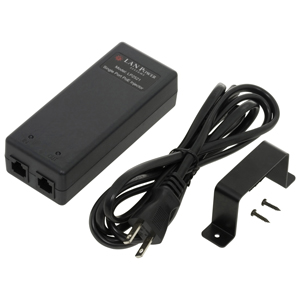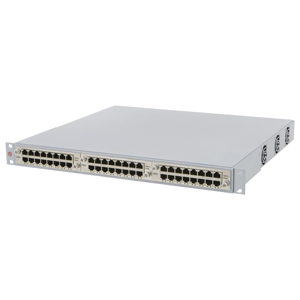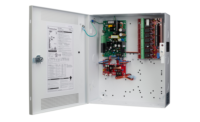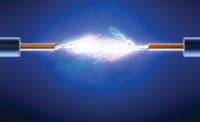
|
| The LAN Power Single Port Injector can provide power up to 28 watts, exceeding the 802.3af and 802.3at standards. |
Virtually every wired camera, access control reader, intercom or other device we install for our clients requires some kind of power for the unit to operate. The powering of devices is always a concern for technicians and, as has been common in our industry for the past century, different vendors will use different methods to power their devices.
IP products are no different. Some vendors supply their cameras or encoders with plug-in AC transformers that usually provide 5 or 12 VDC to the camera. There are several problems when using this power option. First, there must be an AC outlet available near to where the device is to be mounted. If no AC outlet is nearby, the client must pay an electrician to install a separate outlet. Plug-in transformers can be easily unplugged, either intentionally or accidentally, killing the power to the security device. AC power failure also will stop the device from functioning, and it’s possible that a client may inadvertently flip a circuit breaker, again stopping the power to the device.
Many devices also offer the option of direct current voltage inputs, usually 12 or 24 VDC, which can be provided by separate centralized power supplies. While this approach eliminates the need for a nearby AC outlet, extra cables must be run from the power supply to the device, additional standby batteries are required, cost for the power supplies is added to the system, and technicians must make careful calculations regarding the gauge of power cable used and the distance(s) to the devices. This is generally the most common approach used by security dealers today.
It’s time for our industry to take its cue from standardized IT technology and embrace Power over Ethernet (PoE). Established by the IEEE, the 802.3af standard provides up to 12.95 watts of usable power to the end device, while thelatest upgraded standard, 802.3at, provides for up to 25.5 watts. Both standards operate at 48 VDC delivered to the end device.
PoE is provided by either network switches with built-in PoE on some or all of the switch ports. PoE can also be added to networks with what are termed mid-span devices. The name for either of these types of devices is Power Sourcing Equipment, or PSE. The device receiving the power is called a powered device or PD. PoE is delivered on Cat 5e or above rated cable, and the maximum distance between the PSE and the PD is 100 meters or 328 feet.

|
| LAN Power PoE mid-span hubs are modular and can provide higher than minimum 802.3af and 802.3at current for field devices. |
What’s critical for dealers to understand is that using PoE will save money and installation time on the job. No electrician needs to be contracted to provide new outlets and no extra cabling needs to be pulled to the device to power it. With today’s cost of copper, those 16- and 18-gauge power pairs are getting more expensive. PoE just needs common Cat5e, which you must install anyway to connect a wired device to a client’s network.
Now that we’ve got the basics down, let’s take a look at how a new vendor, LAN Power, has devised a family of products that exploit PoE power for the maximum benefit of alarm installers.
Single Device Injector. If just a single device needs PoE, the LP2521 is a very simple 802.3af and 802.3at compliant device that provides a maximum of 28 watts of 48 VDC power to the connected IP camera, video encoder, or other network device. This device also can be connected to LAN Power voltage adapters, which convert the PoE output to 24 VDC, 12 VDC, or 5 VDC.
Multi-Device Mid-Span PSE. PoE power can be centrally provided by using the LAN Power “Cobra” mid-span hub system. The LP2403 chassis is a 19-in. rack-mount housing that can hold up to three LP2408 eight-port modules for a total of 24 powered devices. What’s important here is that LAN Power has configured their devices so that all eight ports on each module can simultaneously provide up to 18 watts of 802.3af standardized power. If more power is available, the LP2404 is a four-port module that delivers 36 watts simultaneously.
PoE Voltage Adapters. Sometimes we need power that isn’t PoE. Wouldn’t it be nice to get 12, 24, or 5 VDC current to a remote device using standard Cat5e cabling? LAN Power has a family of voltage adapters that take incoming standardized PoE power and convert it to one of the voltages listed above.
Standardizing the Power
Why should dealers be looking at these powering options? The first reason is that, like it or not, our industry is moving towards IP connectivity for all physical security devices. With IP as today’s reality, doesn’t it make sense to use the powering standard from the IT industry? Many clients already have PoE-enabled network switches so those can be the basis of powering our field devices. When connected to a UPS, power to the devices will be generally cleaner, resulting in fewer devices “locking up” and requiring a manual reset after a brownout or AC power bump. Even inexpensive UPSs provide network connectivity so that what amounts to the primary power system for our security devices can be remotely diagnosed, and if necessary reset. A UPS can provide some limited backup power to keep our systems running if primary power fails.
Learn more about LAN Power at www.lan-power.com.
| Online Fiber Optic Training |
| Each day more installation companies are finding opportunities to use existing fiber optic links to connect analog and IP cameras, access control, intercoms and other physical security devices. If you would like to learn how to use fiber, check out this online fiber optic training class available at www.fiberopticsinstitute.com. The cost has been reduced to $49 per student and you can learn everything you need to know about fiber right from your home or business |


